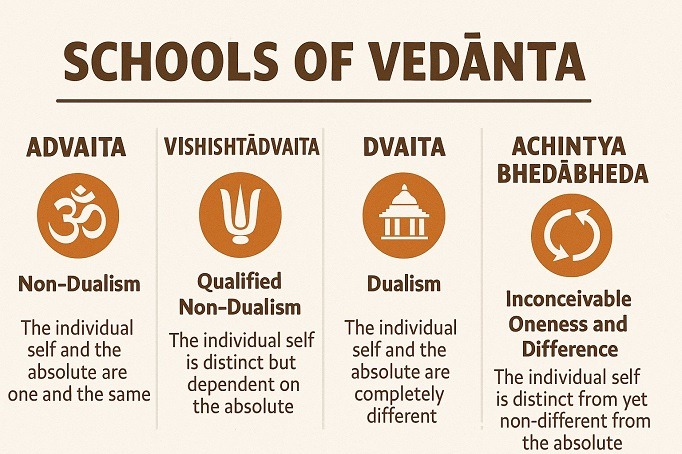
Vedānta—literally meaning “the end of the Vedas”—is the philosophical core of Indian spiritual thought. Rooted in the Upaniṣads, Brahma Sūtras, and the Bhagavad Gītā, Vedānta has evolved through the insights of various revered spiritual teachers (ācāryas) who established distinct schools of thought within the tradition.
In this guide, we explore six major Vedantic schools, all acknowledged in the Vaiṣṇava sampradāya tradition, each offering a unique lens through which to view the eternal truths of existence.
📜 Comparative Overview
| School | Originator / Ācārya | Time Period | Metaphysics | Supreme Brahman |
|---|---|---|---|---|
| Advaita Vedānta | Śrī Ādi Śaṅkarācārya | ~8th century CE | Non-dualism – only Brahman is real | Nirguṇa Brahman |
| Viśiṣṭādvaita Vedānta | Śrī Rāmānujācārya | 11th–12th century CE | Qualified non-dualism | Viṣṇu / Nārāyaṇa |
| Dvaita Vedānta | Śrī Madhvācārya | 13th century CE | Dualism – eternal difference | Viṣṇu |
| Bhedābheda Vedānta | Śrī Nimbārka, Bhāskara | 7th–13th century CE | Difference and non-difference | Viṣṇu / Kṛṣṇa |
| Śuddhādvaita Vedānta | Śrī Vallabhācārya | 15th–16th century CE | Pure non-dualism (Grace Path) | Śrī Kṛṣṇa |
| Achintya Bhedābheda | Śrī Caitanya Mahāprabhu | 15th–16th century CE | Inconceivable unity-in-difference | Śrī Kṛṣṇa |
🌟 1. Advaita Vedānta – Absolute Non-dualism
- Founder: Śrī Ādi Śaṅkarācārya (c. 788–820 CE)
- Sampradāya: Śankara Paramparā
- Core Idea: Only Brahman is real (satya); the world and the individual soul (jīva) are ultimately illusory (mithyā).
- Key Scriptures:
- Tat tvam asi – Chāndogya Upaniṣad 6.8.7
- Aham Brahmāsmi – Bṛhadāraṇyaka Upaniṣad 1.4.10
- Brahma Sūtra 1.1.4 – Tattu samanvayāt
🛤 Path: Jñāna Yoga (knowledge and renunciation)
🎯 Goal: Liberation from māyā; merging into Brahman
🌸 2. Viśiṣṭādvaita Vedānta – Qualified Non-dualism
- Founder: Śrī Rāmānujācārya (1017–1137 CE)
- Sampradāya: Śrī Sampradāya (Lakṣmī lineage)
- Core Idea: Brahman is one, with jīvas and jagat as real parts (body) of Nārāyaṇa. The soul remains individual yet inseparably connected.
- Key Scriptures:
- Sarvaṁ khalvidaṁ brahma – Chāndogya Upaniṣad 3.14.1
- Mamaivāṁśo jīva-loke – Bhagavad Gītā 15.7
- Brahma Sūtra 1.1.1 – Athāto brahma jijñāsā
🛤 Path: Bhakti with Śaraṇāgati (surrender)
🎯 Goal: Eternal service to Nārāyaṇa in Vaikuṇṭha
🔱 3. Dvaita Vedānta – Dualism
- Founder: Śrī Madhvācārya (1238–1317 CE)
- Sampradāya: Brahma Sampradāya
- Core Idea: There is an eternal distinction between jīva, Brahman, and prakṛti (matter).
- Key Scriptures:
- Nityo nityānāṁ cetanaś cetanānām – Kaṭha Upaniṣad 2.2.13
- Mat-sthāni sarva-bhūtāni – Bhagavad Gītā 9.4
- Doctrine of pañca-bheda tattva – fivefold eternal differences
🛤 Path: Bhakti and strict obedience to Viṣṇu
🎯 Goal: Residence in Vaikuṇṭha under Viṣṇu’s mercy
🔥 4. Bhedābheda Vedānta – Difference and Non-difference
- Key Teachers: Śrī Nimbārka (7th century CE), Bhāskara (8th century CE)
- Sampradāya: Kumāra Sampradāya
- Core Idea: The soul is both different and non-different from Brahman, emphasizing a harmony of oneness and diversity.
- Key Scriptures:
- Yathā agneḥ kṣudrā visphuliṅgā vyuccaranti – Bṛhadāraṇyaka Up. 2.1.20
- Mamaivāṁśaḥ jīva-loke – Bhagavad Gītā 15.7
🛤 Path: Balanced Bhakti with humility
🎯 Goal: Personal loving service to Bhagavān
🌼 5. Śuddhādvaita Vedānta – Pure Non-dualism
- Founder: Śrī Vallabhācārya (1479–1531 CE)
- Sampradāya: Rudra Sampradāya
- Core Idea: Kṛṣṇa alone is real, and the world is His divine līlā—not illusion. The soul is an expression of His bliss (ānanda), and grace (puṣṭi) is central.
- Key Scriptures:
- Kṛṣṇas tu bhagavān svayam – Śrīmad Bhāgavatam 1.3.28
- Sarvaṁ khalvidaṁ brahma – Chāndogya Upaniṣad 3.14.1
- Philosophies elaborated in Ṣoḍaśa Grantha and Subodhinī
🛤 Path: Bhakti through Divine Grace
🎯 Goal: Participate in Kṛṣṇa’s līlā with intimacy
🎶 6. Achintya Bhedābheda Vedānta – Inconceivable Oneness and Difference
- Founder: Śrī Caitanya Mahāprabhu (1486–1534 CE)
- Sampradāya: Brahma-Madhva-Gauḍīya Sampradāya
- Core Idea: The soul is inconceivably one and different from Kṛṣṇa. This paradox is realized only through bhakti, not logic.
- Key Scriptures:
- Acintyāḥ khalu ye bhāvāḥ na tāṁs tarkeṇa yojayet – Mahābhārata, Bhīṣma Parva 5.22
- Vadanti tat tattva-vidas… advaya-jñāna – Śrīmad Bhāgavatam 1.2.11
- Bhagavad Gītā 9.4–5 – On immanence and transcendence
🛤 Path: Rāgānugā Bhakti → Prema (spontaneous love)
🎯 Goal: Eternal loving service to Śrī Kṛṣṇa in Vraja
📊 Comparative Table (Extended)
| School | Supreme Brahman | Jīva-Brahman Relation | World Reality | Liberation Goal | Path |
|---|---|---|---|---|---|
| Advaita | Nirguṇa Brahman | Jīva is Brahman | Illusory | Merging into Brahman | Jñāna Yoga |
| Viśiṣṭādvaita | Viṣṇu / Nārāyaṇa | Part of Brahman | Real | Eternal service in Vaikuṇṭha | Bhakti + Surrender |
| Dvaita | Viṣṇu | Completely distinct | Real | Serve Viṣṇu | Bhakti |
| Bhedābheda | Viṣṇu / Kṛṣṇa | Same & different | Real | Serve with retained identity | Bhakti |
| Śuddhādvaita | Kṛṣṇa | Real part of līlā | Real & Divine | Enter His līlā | Bhakti + Grace |
| Achintya Bhedābheda | Kṛṣṇa (Svayam Bhagavān) | Inconceivably same & diff. | Real | Vraja-sevā in Prema | Rāgānugā Bhakti |
🌺 Conclusion
The beauty of Vedānta lies not in rigid uniformity but in its profound diversity. From impersonal realization to the sweetest personal devotion, these philosophies reflect the depth and dynamism of Sanātana Dharma.
By embracing and understanding these varied paths, we don’t merely learn about different philosophies—we grow in humility, tolerance, and spiritual insight. Let us celebrate this journey of knowledge, surrender, and love.
